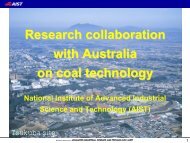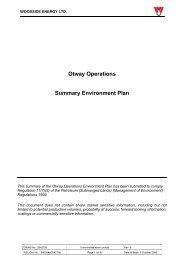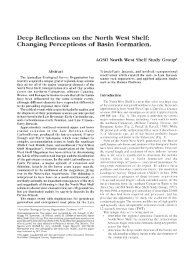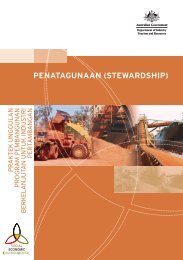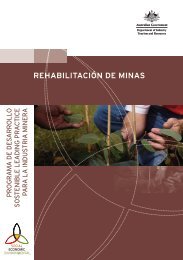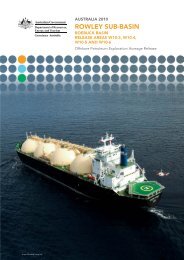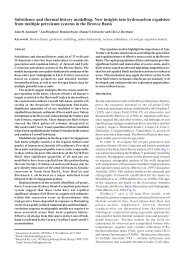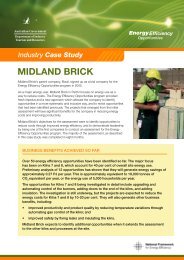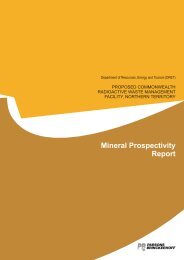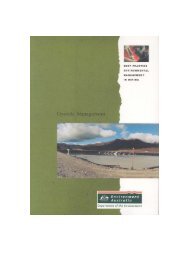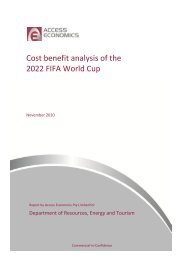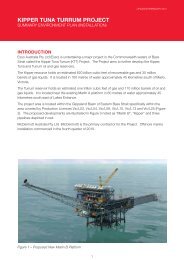A guide to leading practice sustainable development in mining
A guide to leading practice sustainable development in mining
A guide to leading practice sustainable development in mining
Create successful ePaper yourself
Turn your PDF publications into a flip-book with our unique Google optimized e-Paper software.
Water Management (LP Water)<br />
This handbook addresses <strong>susta<strong>in</strong>able</strong> priorities with<strong>in</strong> the m<strong>in</strong><strong>in</strong>g sec<strong>to</strong>r for water<br />
management. Water is <strong>in</strong>tegral <strong>to</strong> virtually all m<strong>in</strong><strong>in</strong>g activities and typically the<br />
prime medium that can carry pollutant <strong>in</strong><strong>to</strong> the wider environment. It can also<br />
be a major source of community concern relat<strong>in</strong>g <strong>to</strong> its usage, particularly <strong>in</strong><br />
areas with established reliance on agricultural or other water <strong>in</strong>tensive <strong>in</strong>dustries.<br />
Consequently, sound water management is fundamental for all m<strong>in</strong><strong>in</strong>g operations.<br />
Water must be managed at all stages of the life cycle of m<strong>in</strong>erals operations. A key<br />
pr<strong>in</strong>ciple <strong>to</strong> sound water management is the recognition of water as an asset with<br />
social, cultural, environmental, and economic value.<br />
Work<strong>in</strong>g with Indigenous Communities (LP Indigenous)<br />
This handbook acknowledges the traditional and his<strong>to</strong>rical connection that<br />
Aborig<strong>in</strong>al people have <strong>to</strong> the land, and the effects of colonisation and <strong>development</strong>,<br />
<strong>in</strong>clud<strong>in</strong>g m<strong>in</strong><strong>in</strong>g. It will also address cross cultural issues and how m<strong>in</strong>e operations<br />
impact on neighbour<strong>in</strong>g Indigenous communities. Issues <strong>to</strong> do with the recognition<br />
of land rights and native title are discussed as well as how relationships are<br />
developed and fostered between m<strong>in</strong><strong>in</strong>g companies and Indigenous communities<br />
through agreement mak<strong>in</strong>g. Recognition of differences <strong>in</strong> culture, language, law and<br />
cus<strong>to</strong>m are an important part of these processes, and some pr<strong>in</strong>ciples of community<br />
engagement are discussed.<br />
This reference <strong>guide</strong> consolidates the <strong>in</strong>formation <strong>in</strong> the handbooks <strong>in</strong><strong>to</strong> a s<strong>in</strong>gle<br />
reference <strong>guide</strong>, organised <strong>in</strong> such a way <strong>to</strong> reflect the life cycle of a m<strong>in</strong><strong>in</strong>g<br />
operation. Reflect<strong>in</strong>g their importance <strong>in</strong> highlight<strong>in</strong>g the key messages, selected<br />
case studies have been reta<strong>in</strong>ed. The handbooks have proven <strong>to</strong> be extremely<br />
popular <strong>in</strong>ternationally and therefore <strong>in</strong> this reference book, a number of<br />
<strong>in</strong>ternational case studies have been used <strong>to</strong> emphasise the global applicability of the<br />
key messages. These case studies were not <strong>in</strong> the LP handbooks.<br />
Chapter 1 provides the background and context and attempts <strong>to</strong> def<strong>in</strong>e the concept of<br />
<strong>susta<strong>in</strong>able</strong> <strong>development</strong> and m<strong>in</strong><strong>in</strong>g. Chapters 2 <strong>to</strong> 5 reflect the life cycle of a m<strong>in</strong><strong>in</strong>g<br />
operation, commenc<strong>in</strong>g with pre-<strong>development</strong> (m<strong>in</strong>eral exploration and feasibility),<br />
<strong>development</strong> (construction and <strong>in</strong>frastructure), operations (m<strong>in</strong><strong>in</strong>g and process<strong>in</strong>g)<br />
and post-<strong>development</strong> (rehabilitation and closure). The Chapters are <strong>in</strong> turn arranged<br />
<strong>in</strong> the key areas of <strong>susta<strong>in</strong>able</strong> <strong>development</strong> reflected by the 14 themes listed above.<br />
The structure is designed <strong>to</strong> enable a reader <strong>to</strong> quickly access a key area of<br />
susta<strong>in</strong>ability throughout the life cycle of a m<strong>in</strong>e. For example a m<strong>in</strong>e manager may<br />
be <strong>in</strong>terested <strong>in</strong> <strong>lead<strong>in</strong>g</strong> <strong>practice</strong>s <strong>in</strong> water course diversion dur<strong>in</strong>g the <strong>development</strong><br />
phase of a m<strong>in</strong>e. The key po<strong>in</strong>ts and a case study highlight<strong>in</strong>g the po<strong>in</strong>ts are provided<br />
<strong>in</strong> Chapter 3, <strong>development</strong> and construction, water management.<br />
Although this <strong>guide</strong> was primarily the work of a s<strong>in</strong>gle author, there were numerous<br />
contribu<strong>to</strong>rs <strong>to</strong> it, pr<strong>in</strong>cipally through their work <strong>in</strong> the orig<strong>in</strong>al Handbook<br />
compilation. Individual contribu<strong>to</strong>rs are listed at the end of this <strong>guide</strong>. It is stressed<br />
that this <strong>guide</strong> is a consolidation of the Handbooks and where relevant, selected<br />
sections are re-emphasised <strong>in</strong> this publication.<br />
A GUIDE TO LEADING PRACTICE SUSTAINABLE DEVELOPMENT IN MINING 5



